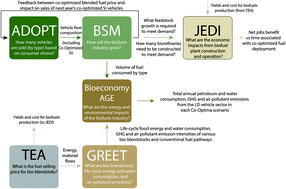Energy, economic, and environmental benefits assessment of co-optimized engines and bio-blendstocks†
Abstract
Advances in fuel and engine design that improve engine efficiency could lower the total cost of vehicle ownership for consumers, support economic development, and offer environmental benefits. Two fuel properties that can enhance the efficiency of boosted spark ignition engines are research octane number and octane sensitivity. Biomass feedstocks can produce fuel blendstocks with these properties. Correspondingly, using a suite of models, we evaluated the change in energy and water consumption and greenhouse gas and air pollutant emissions in the light duty fleet from 2025 to 2050 when bio-blendstocks isopropanol, a methylfuran mixture, and ethanol are blended at 31%, 14%, and 17%, respectively, with petroleum. These blended fuels increase engine efficiency by 10% when used with a co-optimized engine. In these scenarios, we estimated that petroleum consumption would decrease by between 5–9% in 2050 alone and likely by similar levels in future years as compared to a business as usual case defined by energy information administration projections. Overall, between 2025 and 2050, we determined that, when isopropanol is the bio-blendstock, GHG emissions, water consumption, and PM2.5 emission cumulative reductions could range from 4–7%, 3–4%, and 3%, respectively. Cumulative reductions would continue to increase beyond 2025 as the technology would gain an increasing foothold, indicating the importance of allowing time for technology penetration to achieve desired benefits. Annual jobs increased between 0.2 and 1.7 million in the case in which isopropanol was the bio-blendstock. Overall, this analysis provides a framework for evaluating the benefits of deploying co-optimized fuels and engines considering multiple energy, environmental, and economic factors.



 Please wait while we load your content...
Please wait while we load your content...